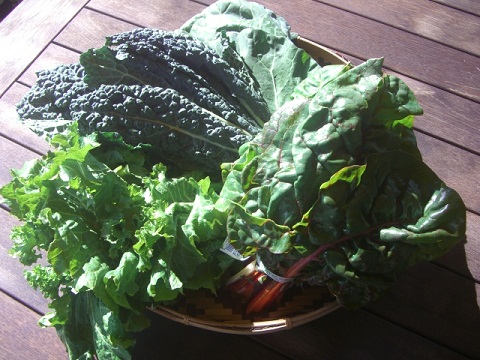A recent trip to my favorite farmers market on a Sunday morning left me clutching an overladen shoulder sack filled to bursting with all manner of glorious fruits and veggies that had seduced me with their siren songs. "JUICE," I muttered to myself to justify my lack of self-control, "I'll make lots and lots of fresh juice!" And with the profusion of produce that is tumbling over sidewalks and curbs of farmers markets throughout Los Angeles as summer approaches its zenith, I recommend you do the same.
Let me say this right off the bat: Everything scientifically-based that I have read leads me to the conclusion that juicing should be an adjunct to one's normal vegetable and fruit intake, not a replacement. But employed sensibly, juicing can be an excellent way to get more and varied produce into your family's diet, and help you to achieve your desired daily dose of vitamin-rich goodness. Not to mention it can provide one of life's more satisfying sensory pleasures.
The primary advantage of juicing is to introduce a greater abundance of health-promoting produce into your daily life; juicing gives you a concentrated dose of vitamins and other nutrients and allows you to enjoy some vegetables that you might otherwise avoid. The downside is that juicing removes a large portion of the fiber and some nutrients (unless you're using only the blender) and can be deceptively laden with calories.
So the key is to choose your ingredients carefully, match them well, and use the blender whenever possible to preserve as much fiber and nutrition as possible. Here are a few tips to help you accomplish that:
Go For The Green. Leafy greens have high concentrations of useful vitamins and minerals and little sugar. Combining them with a little fruit and a splash of citrus makes them not only palatable but delightful.
Wet Your Whistle. Things like cucumber, celery and fennel have a higher water content and mild flavor, and will contribute to a more harmonious texture and flavor.

Watch Out For The Fruit. Yes, fruit is the tastiest part of juicing; it is also the most fattening, not to mention contributing to sugar spikes. Use it more as a flavoring, and allow the vegetables to shine. Also note that vegetables such as beets and carrots are high in carbs, and they too should be used judiciously.
Try Something New. You may find that some vegetables you never liked before are much more appealing as part of a juice cocktail. Try cabbage, kale, or red leaf lettuce, and toss in a little parsley or cilantro as well.
Add A Little Zing! Accentuate the flavors and brighten your juices with some perky additions: a bit of chopped fresh ginger, a squeeze of Meyer lemon, a dash of cayenne pepper or ground cumin, even a couple of cranberries -- these will enhance the taste and offer their own little nutritional contribution.
Drink It Now. Juiced produce rapidly degrades, losing its nutritional peak and becoming prone to spoilage, so plan to enjoy your juice immediately upon making it. If you want to hold it for a few hours, fill a container with a tight lid all the way to the top and keep it well-refrigerated.
Basically there are three ways to achieve juicing lift off: a citrus juicer for oranges and lemons and such; a blender for softer stuff and liquids; and a juicing machine for firmer and leafy items. You'll probably want all three to do some serious juicing. The citrus juicer and the blender of course have multiple uses and can already be found in most kitchens; your choice of a juicing machine should probably be based on your frequency of juicing and your budget.
There are three kinds of juicing machines: centrifugal, masticating, and triturating. Centrifugal is the cheapest and the least effective, in that it produces some heat and removes the largest amount of fiber. Masticating is in the mid-price range, and is thought to preserve a little more of the fiber. Triturating is the most expensive and the most effective, as it presses the produce to extract the maximum amount of juice. In any event, it is always a good idea to put a little of the removed fiber back into your juice, whichever machine you choose.
So your next trip to the farmers market, stock up on a basketful of the freshest and sweetest the season has to offer, and give it a whirl!
Blender Breakfast Whirl
Start your day off right with this quick and easy concoction...
1 sweet/crisp apple, like a Pink Lady, cored and chopped*
A handful of sorrel leaves, ribs removed & leaves shredded
1/2 cup chopped cucumber
1 tablespoon fresh Meyer lemon juice
1 teaspoon minced fresh ginger
Dash of cayenne pepper
1/3 cup water
A couple of ice cubes
*You can peel the apple if you like, though I enjoy the texture of the peels myself, and of course you retain more of the nutrition that way.
Combine all ingredients in a powerful blender (I wouldn't use anything but my trusty Vita-Mix). Start slow, then turn to high and puree until smooth. Add more water if it's too thick. Pour into a chilled glass and enjoy!
Bloody Delicious
You'll need a citrus juicer and a juicing machine for this, finishing in the blender. This is a high-calorie treat for an occasional indulgence...
4 large blood oranges, halved
1/2 medium ruby beet, halved
1/2 medium golden beet, halved
1/4 cup blackberries
1/4 cup raspberries
1 tablespoon Meyer lemon juice
1/2 tablespoon organic local honey
Juice the blood oranges. Juice the beets. Combine them with the rest of the ingredients in the blender and puree until smooth. Pour into a chilled glass and serve.
[Note: A version of this post appears in my "Eat Smart" column in the June issue of Better Nutrition Magazine.]
For more by Neil Zevnik, click here.
For more on diet and nutrition, click here.
